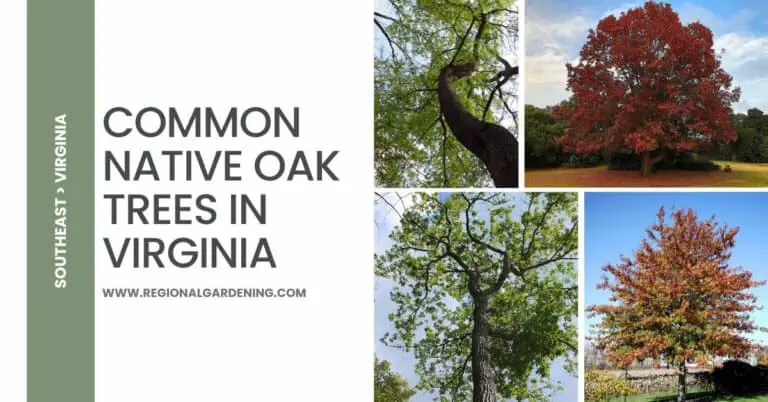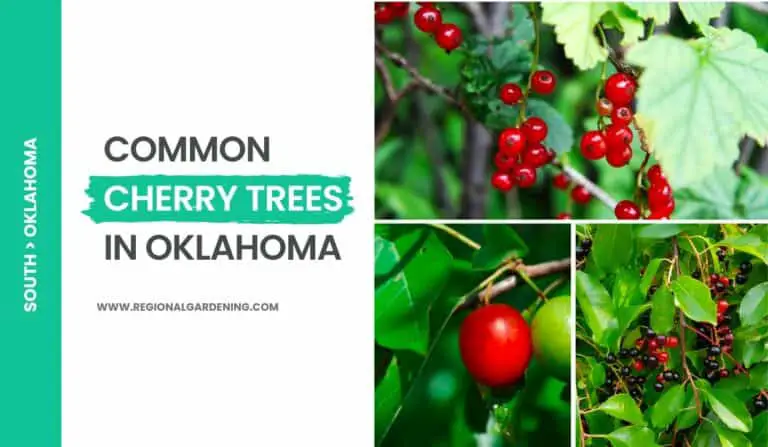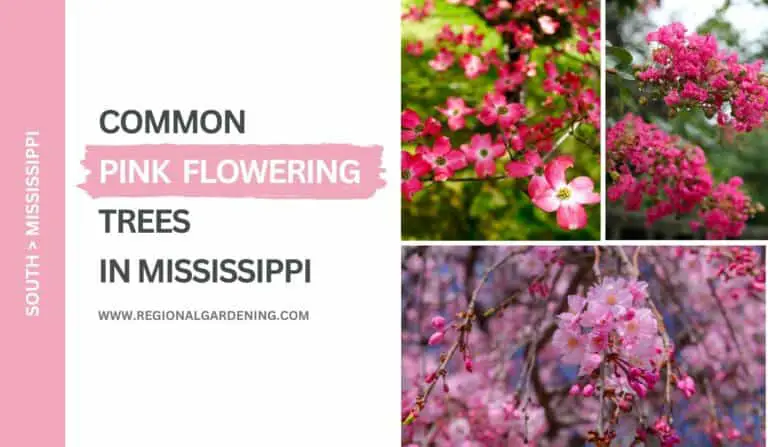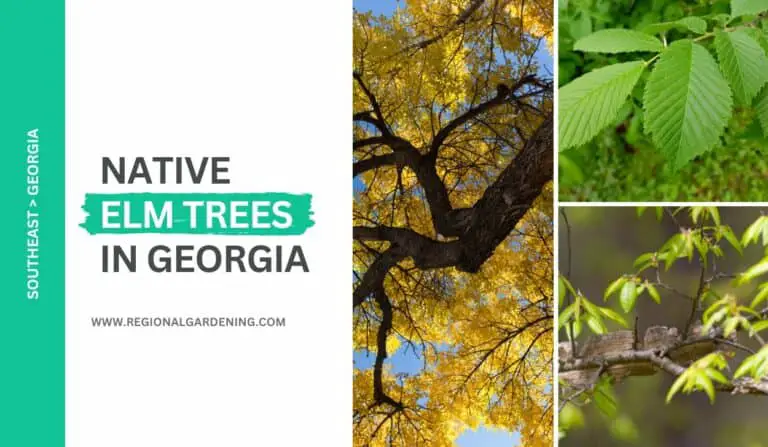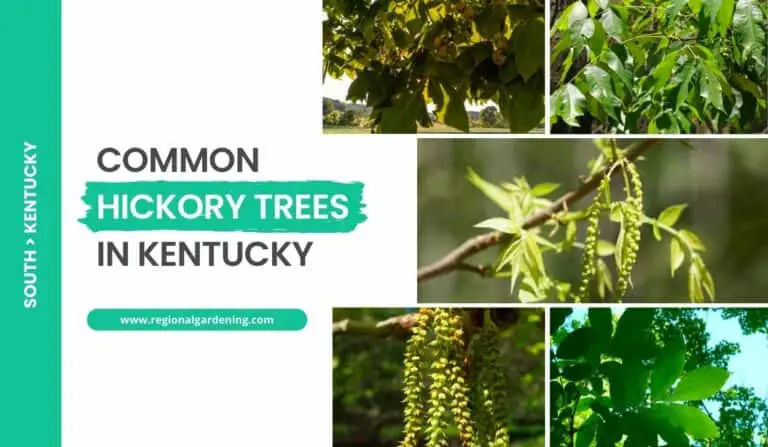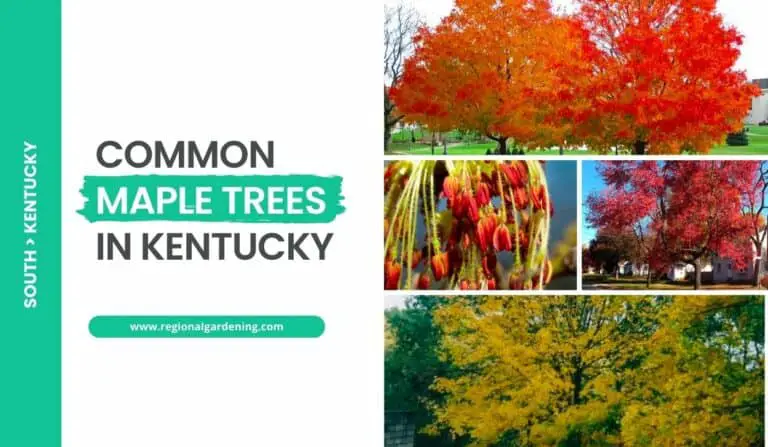Stunning Purple Trees In Georgia (7 Stunning Varieties)
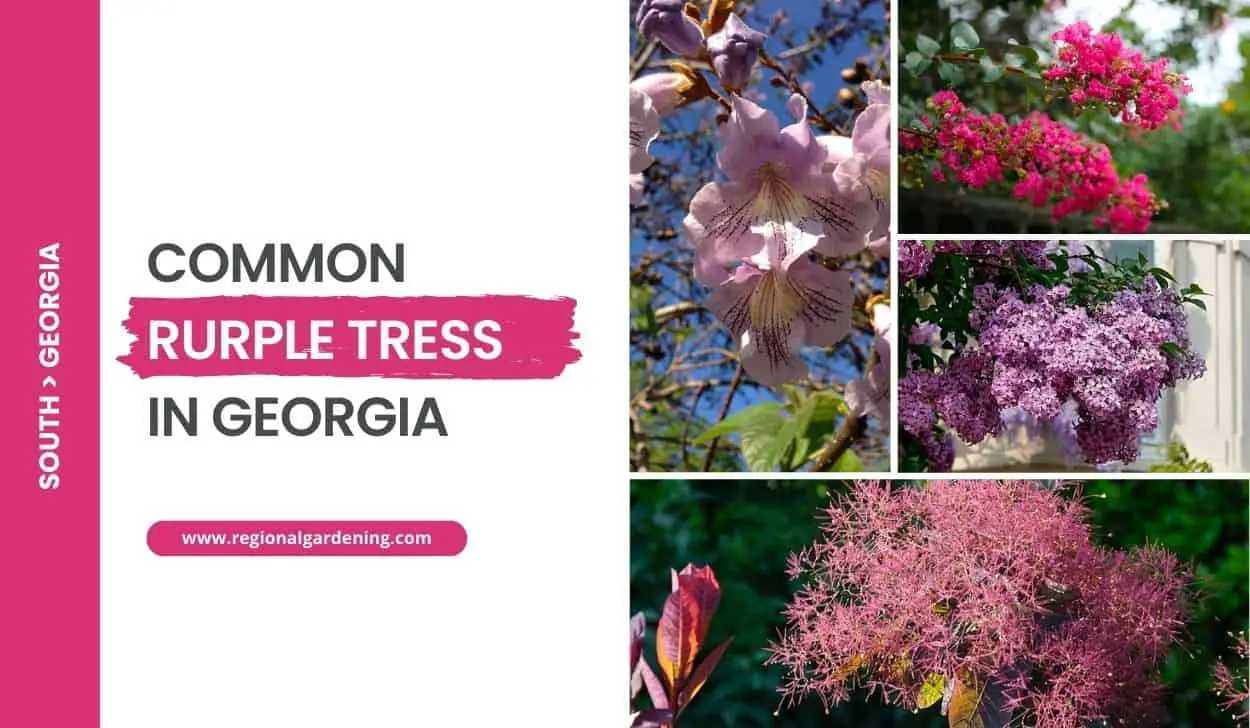
Georgia’s vibrant landscapes are not just a sea of green; they are also adorned with breathtaking purple hues.
In this article, we take a journey through the most common purple trees in Georgia, highlighting seven stunning varieties that paint the landscape with their regal hues.
We will reveal the botanical wonders that add a touch of royalty to Georgia’s natural beauty, from the elegant Eastern Redbud with its blush-pink blossoms to the stately Purple Crape Myrtle with velvety purple blooms.
So, let’s begin.
1. Purple Crape Myrtle
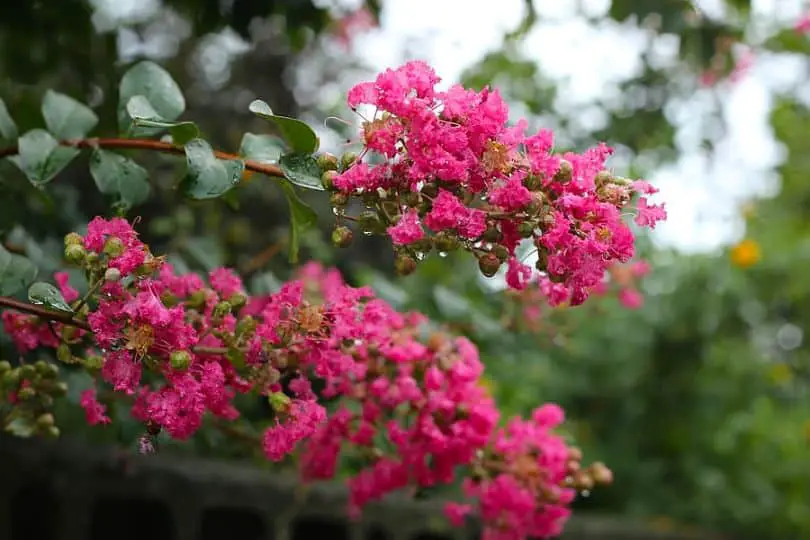
- Scientific Name: Lagerstroemia indica
- Common Name(s): Purple crape myrtle, crepe myrtle
- Mature Height: 10-25 feet (3-8 meters)
- Native Region: Southeast Asia
- Flowers: Purple, crepe-like flowers arranged in clusters
- Fruit: Small, round capsules containing tiny seeds
- Uses: Ornamental trees in gardens and landscapes, often used as specimen trees or in hedges. It provides beautiful summer blooms and attractive fall foliage.
Purple crape myrtle, also known as Lagerstroemia indica, is one of the most popular purple trees in Georgia. It is valued for its brilliant purple blossoms as well as its capacity to survive in hot, humid settings. This deciduous tree can grow to be 10 to 25 feet tall, making it an excellent choice for both small and large gardens.
Purple crape myrtle leaves are simple, opposite, and oval in shape, with a dark green hue. In the fall, they become a rich scarlet or orange, adding to the tree’s visual appeal. Smooth, gray, and speckled bark peels off in parts to reveal a warm cinnamon color beneath.
The purple crape myrtle is native to Southeast Asia and thrives in Georgia’s warm, humid climate. It is a low-maintenance tree that grows best in full sunlight and well-drained soil. It is drought-tolerant and pest- and disease-resistant once established.
Purple crape myrtle blooms with clusters of gorgeous flowers in the summer. The blossoms have a crepe-like texture and colors ranging from pastel lavender to deep purple. They attract butterflies and bees, increasing the ecological value of the tree.
Purple crape myrtle develops small round capsules containing tiny seeds in the fall. These capsules give winter interest to the overall appearance of the tree. Aside from its ornamental value, the purple crape myrtle is frequently employed as a shade tree, a specimen tree, or in privacy hedges.
2. Jacaranda
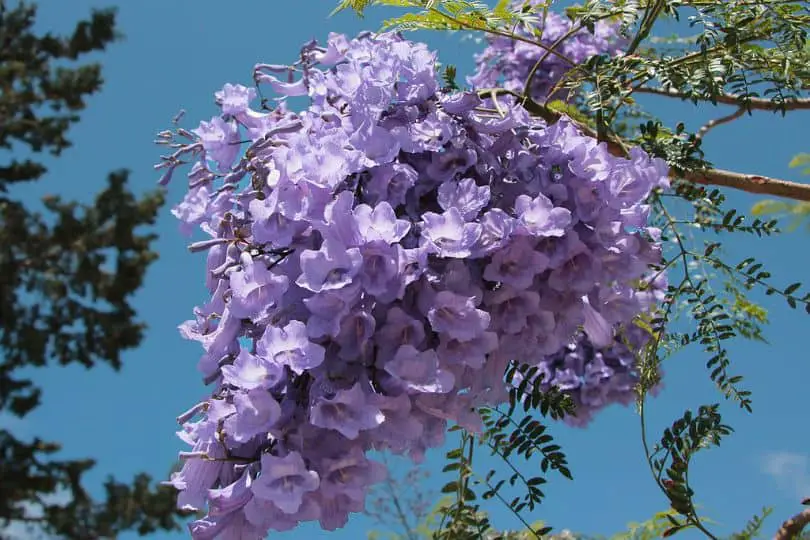
- Scientific Name: Jacaranda mimosifolia
- Common Name(s): Jacaranda, Blue Jacaranda, Fern Tree
- Mature Height: 40-50 feet (12-15 meters)
- Native Region: South America
- Flowers: Clusters of tubular lavender-blue flowers
- Uses: Ornamental tree, timber production
The Jacaranda tree, scientifically known as Jacaranda mimosifolia, may be found across Georgia. This lovely tree is native to South America and can grow to be 40 to 50 feet (12 to 15 meters) tall when mature. The Jacaranda is popular for its beautiful display of lavender-blue blooms that gather in bunches and make a gorgeous spectacle. These tubular blossoms provide a pop of color to any setting.
The Jacaranda tree can be identified by its fern-like, pinnately complex leaves. The leaves are semi-deciduous, which means they drop during dry seasons but regrow the following growing season. The bark of the Jacaranda is grayish-brown and smooth.
The Jacaranda adapts well to the warm environment of Georgia and prefers full sun exposure. It should be noted that this tree requires well-drained soil to thrive, so it should be avoided in places with poor drainage. Once grown, the Jacaranda requires little care and can withstand periods of drought.
The Jacaranda tree is typically grown as an ornamental tree. Because of its bright blossoms, it is a popular choice for landscaping and bringing color to gardens. Furthermore, because of its resilience, the wood of the Jacaranda is employed in lumber production. The wood is often used in furniture, cabinetry, and building.
3. Purple-leaf Plum
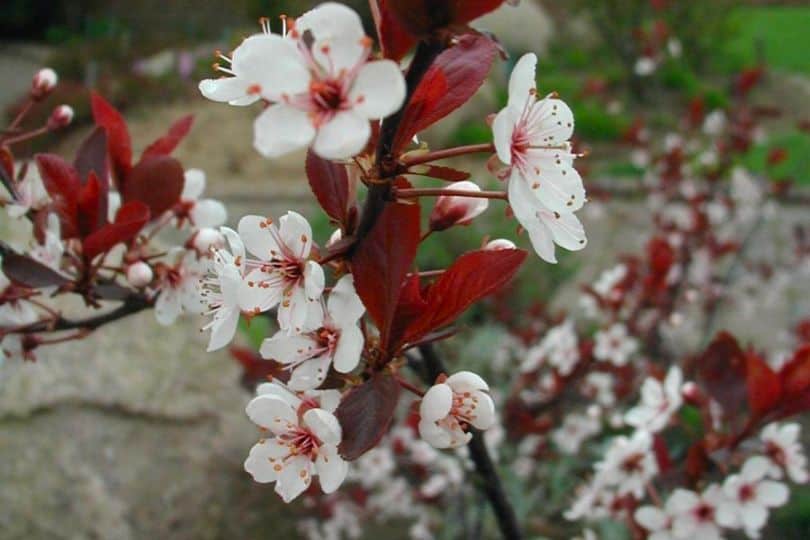
- Scientific Name: Prunus cerasifera
- Common Name(s): Purple-leaf Plum
- Mature Height: 15-25 feet (4.5-7.6 meters)
- Native Region: Native to Western Asia and the Caucasus
- Flowers: Pink to white flowers, bloom in early spring
- Fruit: Small purple drupes, about 1 inch in diameter
- Uses: Ornamental tree, popular for its vibrant purple foliage in spring, and its purple fruits attract birds.
The Purple-leaf Plum, Prunus cerasifera, is a beautiful deciduous tree that is widely seen in Georgia landscapes. It is native to Western Asia and the Caucasus region, growing to a mature height of 15-25 feet (4.5-7.6 meters). This tree is prized for its bright purple foliage, which appears in spring and lasts all summer, bringing a splash of color to the environment.
The Purple-leaf Plum tree bears little pink to white blossoms that bloom before the leaves show in early spring. These flowers stand out beautifully against the purple foliage. Following the blossoms, the tree produces little purple drupes about an inch in diameter. These fruits are not normally consumed by people, but they are appreciated by birds, making the tree an excellent addition to wildlife-friendly gardens.
Purple-leaf Plum trees grow in full sun to light shade and prefer well-drained soil in Georgia landscapes. Once established, it is a sturdy tree that is drought tolerant. Because of its remarkable appearance, this tree is often employed as an ornamental tree in residential and commercial environments. It is suitable for planting as a specimen tree, as a focal point in the landscape, or as part of a mixed planting.
Aside from its decorative qualities, the Purple-leaf Plum tree is utilized in Georgia landscaping to control erosion. Its thick branches and shallow root system aid with soil stabilization and erosion prevention on slopes. This tree also offers habitat and food for birds, adding to the overall ecological balance.
4. Eastern Redbud
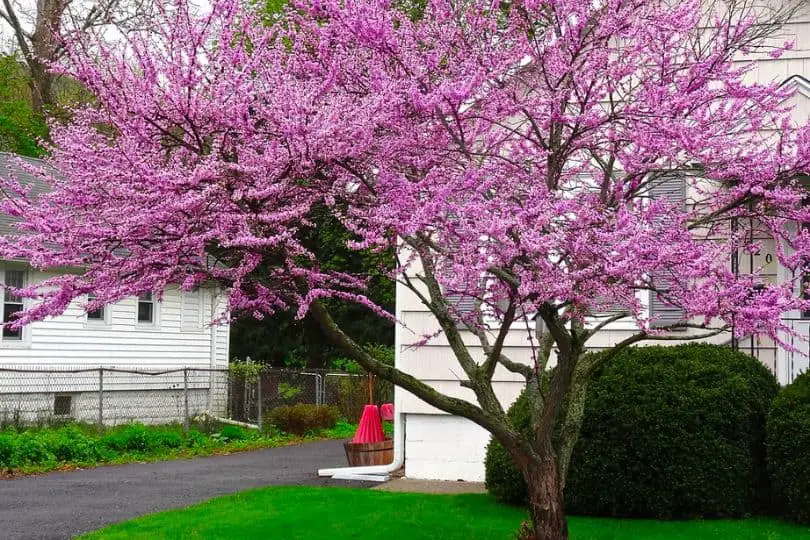
- Scientific Name: Cercis canadensis
- Common Name(s): Eastern Redbud
- Mature Height: 20-30 feet (6-9 meters)
- Native Region: Eastern North America
- Flowers: Pink or purple, small, clustered along the branches in early spring
- Fruit: Flat, brown, leathery pods
- Uses: Ornamental, attracts pollinators like bees and butterflies
The Eastern Redbud, also known scientifically as Cercis canadensis, is a deciduous tree native to eastern North America. It is a small to medium-sized tree that can grow to be 20 to 30 feet (6 to 9 meters) tall.
The Eastern Redbud is well-known for its spectacular display of pink or purple blooms that bloom before the leaves emerge in early April. The flowers are petite and crowded along the branches, providing a visually attractive impression.
Eastern Redbud leaves are heart-shaped and alternate along the branches. They’re a medium green tint that becomes yellow in the fall. The tree’s bark is smooth and gray, gradually forming ridges and furrows as it ages. In the fall, the tree produces flat, brown, leathery pods that lend interest to the landscape and can be utilized for crafts or decorations.
The Eastern Redbud flourishes in several soil types in Georgia landscapes, including sandy, loamy, and clay soils. It prefers well-drained soil and direct to indirect sunlight. Once planted, it is a resilient tree that can withstand drought conditions.
It is often utilized as an ornamental tree in landscapes and gardens, where its vivid blossoms provide early spring color. It can be utilized as a focal point or in groupings to create an eye-catching visual effect. With its nectar-rich blossoms, the Eastern Redbud also attracts pollinators such as bees and butterflies.
The Eastern Redbud has functional uses in addition to its aesthetic significance. The shade-giving tree can be planted to create a naturalized area or woodland garden. The pods that form in the autumn can be utilized to make crafts or decorations.
5. Smoke Tree
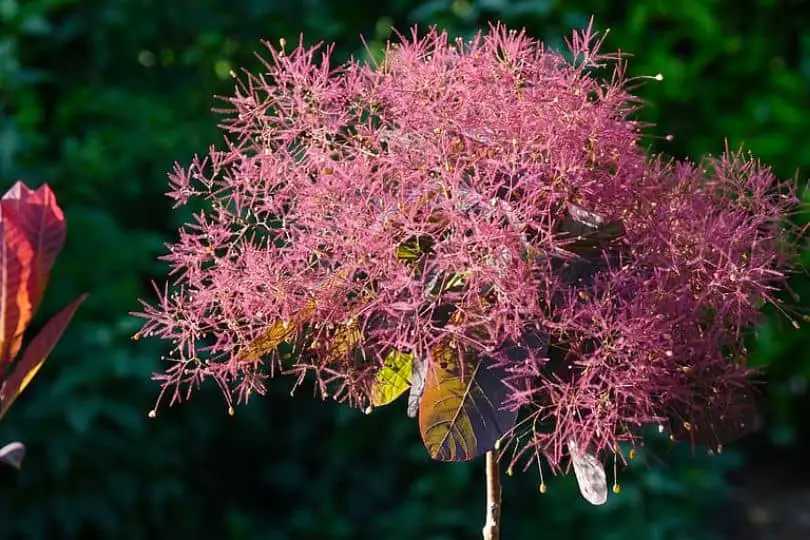
- Scientific Name: Cotinus coggygria
- Common Name(s): Smoke Tree, Smoke Bush, Purple Smoke Tree
- Mature Height: 10-15 feet (3-4.5 meters)
- Native Region: Europe and Central China
- Flowers: Clusters of tiny, feathery pink or purple flowers that resemble puffs of smoke
- Fruit: Small, inconspicuous seed capsules
- Uses: Ornamental tree, used for its unique smoke-like flower clusters in landscaping.
The Smoke Tree, or Cotinus coggygria, is a deciduous tree endemic to Europe and central China. It is well-known for its eye-catching, smoke-like blossom clusters, which give rise to the tree’s name. Because of its distinct appearance, the smoke tree grows to an average mature height of 10-15 feet (3-4.5 meters) and is frequently employed as an attractive tree in landscaping.
The smoke tree can be identified by its enormous, ovate leaves, which turn brilliant colors of red, orange, and purple in the fall. The tree’s bark is smooth and grayish-brown in hue, with a unique texture that develops with age. This tree’s hallmark is the clusters of small, fluffy blooms that emerge in late spring or early summer. The blossoms can be pink to purple and resemble puffs of smoke, hence the tree’s name.
The smoke tree may grow in a range of soil types, but it favors well-drained soils. Once planted, it can withstand full sun to light shade and is drought tolerant. The smoke tree grows well in Georgia landscapes in USDA hardiness zones 5-9. It’s a great choice for adding eye-catching visual interest to gardens, borders, or as a stand-alone specimen.
Aside from its aesthetic appeal, the smoke tree has few functional applications. It is, however, prized mostly for its decorative features rather than for any specific economic or medicinal reasons. The smoke tree is not related to the true smokebush (Cotinus obovatus), a natural species found in the southeastern United States, particularly Georgia.
6. Japanese Lilac
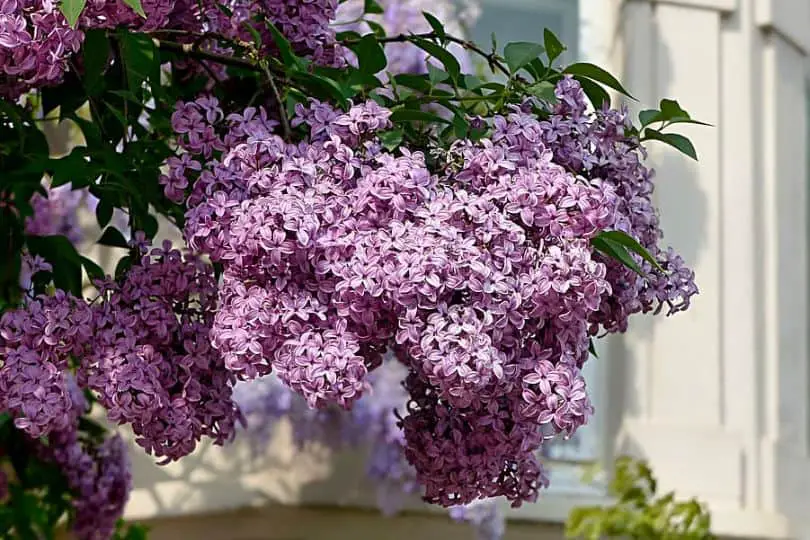
- Scientific Name: Syringa reticulata
- Common Name(s): Japanese Lilac
- Mature Height: 20-30 feet (6-9 meters)
- Native Region: Japan
- Flowers: Purple or white, fragrant panicles
- Fruit: Small, inconspicuous brown capsules
- Uses: Ornamental tree for gardens and landscapes, attracts butterflies and bees, provides shade and privacy.
The Japanese Lilac, Syringa reticulata, is a medium-sized deciduous tree that can reach a mature height of 20-30 feet (6-9 meters). It is native to Japan, but it has become popular as a decorative tree in many regions of the world, including Georgia.
This tree is well-known for its lovely blossoms and pleasant appearance. The Japanese Lilac blooms in enormous, fragrant panicles that are either purple or white in hue. These flowers not only provide an elegant touch to the landscape, but they also attract butterflies and bees, making them an excellent choice for pollinator gardens.
The leaves of the Japanese Lilac are simple, ovate to elliptic in shape, and dark green in color. The bark is grayish-brown with shallow furrows that lend visual character to the overall appearance of the tree. In terms of growing conditions, this tree prefers well-drained soil and full sun to partial shade. It is low-maintenance and can survive urban pollutants, making it suited for Georgian urban environments.
The Japanese Lilac is grown primarily as an ornamental tree, giving beauty and scent to gardens and landscapes. Because of its dense foliage and moderate height, it is also an excellent choice for providing shade and privacy in residential locations. Furthermore, the tree’s ability to attract pollinators contributes significantly to biodiversity promotion.
7. Chaste Tree
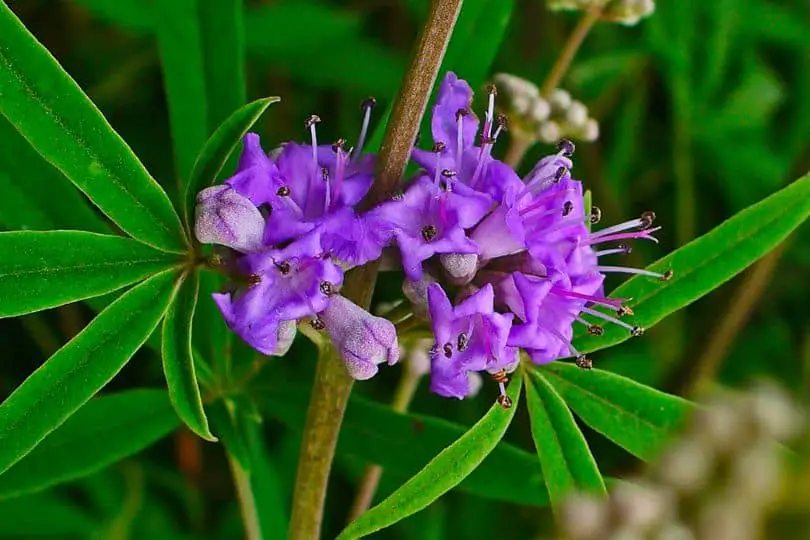
- Scientific Name: Vitex agnus-castus
- Common Name(s): Chaste Tree, Monk’s Pepper
- Mature Height: 6-20 feet (1.8-6 meters)
- Native Region: Mediterranean region, Central Asia
- Flowers: Violet-blue, purple, lavender, or white flowers arranged in dense spikes
- Fruit: Small, round, brown-black berries
- Uses: Ornamental tree, medicinal properties in herbal medicine
The Chaste Tree (Vitex agnus-castus) is a deciduous shrub or small tree that grows to a height of 6 to 20 feet. It is native to the Mediterranean region and Central Asia, but it has spread to other parts of the world, including Georgia. The Chaste Tree is well-known for its lovely violet-blue, lavender, or white flowers, which appear in dense spikes during the summer months and attract butterflies and bees.
The Chaste Tree’s leaves are palmate, which means they are divided into numerous leaflets that radiate from a central point, resembling a hand. When crushed, the gray-green leaves emit a pleasant, aromatic fragrance. The tree’s bark is smooth and grayish-brown.
This tree is ideal for Georgia landscapes since it is drought-tolerant and adaptable to a variety of soil conditions. It enjoys full light but may tolerate some shade. In terms of care, the Chaste Tree requires just minor pruning, which should be done in early spring to remove any dead or damaged wood.
When mature, the Chaste Tree produces small, spherical berries that change from green to brown-black. Even though humans don’t typically eat these berries, herbal medicine has long used them. The tree’s common name, “Chaste Tree,” comes from the assumption that its berries were utilized to inhibit libido in ancient times.
The Chaste Tree is commonly grown as an ornamental tree in Georgia landscapes due to its lovely blossoms and general aesthetic value. It can be utilized as a focal point or as part of a mixed planting in the garden. Furthermore, its nectar-rich blossoms make it an excellent addition to pollinator gardens, attracting bees and butterflies.
Similar Articles
- Native Oak Trees in Georgia
- Native Pine Trees In Georgia
- Native Hickory Trees In Georgia
- Native Maple Trees In Georgia
- Native Tupelo Trees In Georgia
- Native Plum Trees In Georgia
- Native Magnolia Trees In Georgia
- Native Willow Trees In Georgia
- Native Ash Trees In Georgia
- Native Elm Trees In Georgia
- Native Dogwood Trees In Georgia
- Native Cottonwood Trees In Georgia
- Native Cedar Trees In Georgia
- Common Birch Trees In Georgia
- Common Cypress Trees In Georgia
- Common Palm Trees In Georgia
- Common White Flowering Trees In Georgia
Common Purple Trees In Georgia – Sources
The Regional Gardening team makes sure that the information in our articles is accurate by only using sources that are known to be trustworthy. Some of these sources are peer-reviewed journals from government agencies, well-known universities, and scientific research organizations.
- Georgia Native Plant Society
- College Of Agricultural & Environmental Sciences, University Of Georgia
- Native Plants Books, Georgia Native Plant Society
- Georgia Forestry Commission
- Native Plants Of North Georgia, University Of Georgia
- Tree Care, Georgia Tree Council


